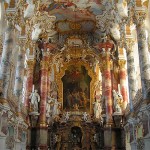XVIth International Baroque Summer Course of the Werner Oechslin Library Foundation, Einsiedeln.
The course is open to doctoral candidates as well as junior and senior scholars who wish to address the topic with short papers (20 minutes) and through mutual conversation. As usual, the course has an interdisciplinary orientation. We hope for lively participation from the disciplines of art and architectural history, but also from scholars of history, literature, theatre, sociology, and other relevant fields. Papers may be presented in German, French, Italian or English; at least a passive knowledge of German is a requirement for participation.
Conditions: The Foundation assumes the hotel costs for course participants, as well as several group dinners and the excursion. Travel costs cannot be reimbursed. Please send applications with brief abstracts and CVs by e-mail to: anja.buschow@bibliothek-oechslin.ch
The CFP deadline is 7 December 2014.
Concept / Organization: Anja Buschow Oechslin, Axel C. Gampp, Werner Oechslin, Tristan Weddigen Introduction: Heinrich Wölfflin introduced his account Classic Art with the psychologizing observation: “The word ‘classic’ has, for us, a rather chilly sound.” One infers that with the Baroque it is the other way around, “heartwarming.” Baroque is lush and exuberant, classic sworn to simplicity; linear ideals here, corporeality there. Such observations born of contrast and contradicition no doubt accompanied the rediscovery and reappraisal of Baroque at the end of the nineteenth century. But with this one is by no means at the end of the matter. In 1908, Riegl confessed – in view of convulsively contorted figures – that did not understand the world anymore, adding, “And that bothers us northern Europeans.” More than the opposition of classic-Baroque, the modern contradiction of north and south and, indirectly, the otherness of a Protestant and a Catholic culture became apparent. In 1931 Wölfflin was still writing, “For the Germanic north, Italy signifies something foreign to its character.” In Renaissance and Baroque in 1888 he set as his goal “to observe the symptoms of decadence and in the ‘brutalization and arbitrariness’ perhaps recognize the principles.” The search for “universal principles of form” was a concern of art history just as of modern architecture, which via this route very quickly attained the honors of being deemed a “style” and “classic.” But in 1888 this path did not suffice beyond Maderno; beyond that apparent regularity there were only psychological horror reports, “frenesia,” suicide and headaches. With “Germanness” as a point of departure, Rudolf Busch argued in 1919, “Our overstimulated nerves no longer tolerate rich ornament.”Folk or national psychology had distorted the view of art history, and now – out of the periodization terms supposedly born of contrast and contradiction – these judgments were also imposed. A clear physiognomy of what Baroque might be became even more evanescent, or, better, did not even materialize. And the “periodization term” baroque described that phase of a divided history that today no less arbitrarily and imprecisely is classified as “early modern.” Was it all for nothing? Conversely, for once it is worthwhile not to investigate what is charcteristic and typical for the Baroque, but rather to turn the tables and and explore which classical notions and aspects of classical culture lived on during that period. One will quickly see that there was no break in this regard, but instead a comprehensive further development of the interests that had been newly discovered at the time of the humanists. And just as rarely as a truly “pagan” world could be identified previously, so little “afterwards” – namely after the Tridentine reforms – did one swear off all classical form and mythology. Varying accents and shifts exist before and after, yet the connecting factors dominate. In the character of an “Antirinascimento” it also involves continuity. To represent continuity also means to carve out differences. In any case culture draws stimuli for rich evolvement from this. After all, the world changes daily, artists and patrons included, and each successor wants to present himself as in some way “different” from his predecessor. The spectrum of possibiliities constantly expands. And precisely for this reason, a view toward a definitive authority is always desired. One holds a mirror to the ancient, classical world, and ties this into one’s own understanding of the world and its history. Wölfflin added another complaint in his introdcution to Classic Art. The interest in “art” had been lost by historically oriented scholarship. All the more, therefore, did he welcome Adolf Hildebrand’s Das Problem der Form in der bildenden Kunst (1893), which was like “a refreshing rainfall on arid soil.” Out of this one could again construct an opposition – though a devastating one – between historical versus classic. What is correct is that the modern conception of classic as timeless can indirectly be interpreted as anti-historical. But the rebirth of the ancient world from all that bound up in the term “Renaissance” was naturally just as comprehensively concerned with history as that which followed, the “baroque” culture that pursued these concerns. The classic can detach itself from history as much as it likes, but it always remains a part of it. And it is worthwhile to investigate all the facets and combinations to also discover the riches that formed out of the constant encounter with antiquity in art and culture. Werner Oechslin


Leave a Reply
You must be logged in to post a comment.